|

 Up
Up 
 Model B
Model B 
(You are here.)



  Need
to Need
to
find your
bearings?
Try
these
navigation aids:
If
this is your first
visit, please stop by:
Something
to share?
Please:



|
|
Available in Française, Español, Português, Deutsch, Россию,
中文,
日本, and others.
 nitially
called the "headless Wright" because the familiar front
canard/elevator was absent, the Model B was the Wright brothers'
most successful aircraft. It was produced from late 1910 to 1914,
and during 1911 and 1912, the Wright Company was shipping four Model
Bs a month out the factory door. nitially
called the "headless Wright" because the familiar front
canard/elevator was absent, the Model B was the Wright brothers'
most successful aircraft. It was produced from late 1910 to 1914,
and during 1911 and 1912, the Wright Company was shipping four Model
Bs a month out the factory door.
The Model B used the same control
system, engine, propellers, air foil, and wing configuration as the
Model A, but the rear outriggers were extended so the rudder and
elevator were further from the wing. The Wright also added wheels
and beefed up the skids. On the whole, the Model B was stronger,
easier to control, easier to launch, and slightly faster than
earlier Wright aircraft.
Wright Model B specifications:
- 39 ft (11.9 m) wingspan
- 6.3 ft (192 cm) chord
- 5.3 ft (162 cm) separation
- 480 sq ft (44.6 sq. m) wing area
- 1:20 camber
- 40
sq ft (3.7 sq m) horizontal rear elevator
- 15 sq ft (1.4 sq m) twin movable vertical rear rudders
- 29.8 ft (9.1 m) overall length
- 800 lbs (363 kg) total weight (without pilot or passenger)
- 4 cylinder engine, 28 to 42 hp running at 1425 to 1500 rpm
- Two contra-rotating propellers, 8.5 ft (259 cm) long, turning
at 450 to 470 rpm
- 44 mph (71 kph) average speed
The Wrights had hoped the new design would re-establish their
technological leadership in aeronautics, but it did not. The rear
elevator made the aircraft more controllable in pitch, but it also
made it tail-heavy and prone to stall. The numerous wires required
to brace the outriggers added drag. In truth, the Model B was
outmoded within two years of its introduction as faster,
inherently stable "tractor" (propeller first) aircraft with
drag-reducing fuselages began to appear.
Nonetheless, the Wright Model B was a popular aircraft and the
exhibition pilots who flew them introduced much of America to
aviation. The Model B also captured a great many aviation records
and firsts:
- First air freight – On 7 November 1910, Phil Parmalee flew two 50-pound (23-kilogram) bolts of silk from
Dayton to Columbus, Ohio, delivering them to Morehouse-Martens
Department Store. He set a new cross-country speed record,
beating a train traveling the same route.
- First live aerial bombs – In January 1911,
Phil Parmalee flew Lt. Myron S. Crissy over Selfridge Field in
San Francisco to demonstrate the feasibility of aerial bombing.
- First military aircraft radio message – On 21
January 1911 Phil Parmalee carried Lt. Paul W. Beck and a
29-pound (13-kilogram) radio telegraph to an altitude of 500
feet (152 meters). Beck tapped out the first air-to-ground
military radio communications
- First military reconnaissance – In the spring
of 1911, Lt. Benjamin Foulois and Phil Parmalee flew scouting
missions along the US-Mexico border.
- First parachute jump from an airplane – Sometime in 1911, Grant
Morton jumped out of a Model B piloted by Phil Parmalee and
parachuted safely to the ground at Venice Beach, California.
- First naval aircraft – On 19 July 1911 the
U.S. Navy purchased its first airplane, a Wright Model B mounted
on pontoons.
- First American president to fly – On 11
October 1910 Arch Hoxsey took former President Theodore
Roosevelt aloft.
- First west-to-east flight across America –
From October 1911 to February 1912 Robert Fowler hopped his
Model B across the U.S. from Los Angeles, California to
Jacksonville, Florida.
- First aerial weaponry – On 7 June 1912
Capt. Charles D. Chandler test-fired a Lewis machine gun in
flight over College Park MD. Lt. Roy Kirtland was the pilot.
Despite the numbers produced and the popularity of the aircraft,
only one Wright Model B has survived intact. It's currently on
display in the Franklin Institute in Philadelphia, Pennsylvania.
There is a second Model B on display at the United States Museum of
the Air Force in Dayton, Ohio, but its pedigree is not crystal
clear. It was apparently manufactured by the Wright Company sometime
after Orville had sold the business to a New York syndicate in 1915.
It was used as a trainer in Long Island and the aircraft may have been modified since
then. Orville, who inspected this machine when it was displayed at
the 1924 International Air Races, found parts of it unfamiliar and
pronounced it a "mongrel."
References:
- McFarland, Marvin W. (ed), "The papers of Wilbur and Orville
Wright." McGraw-Hill Book Co., New York, 1953, p 1183.
|
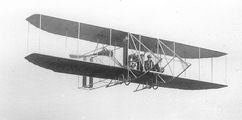
An early Wright Model B in flight. Note that the front skids each
had two diagonal braces.
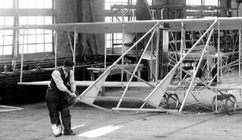
A Wright Model B being assembled in the Wright Company factory in
1911.
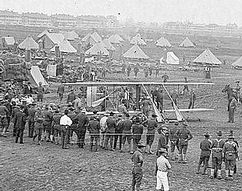
A Model B at Fort Sam Houston near San Antonio, Texas. This was the
first aircraft the US Army used for actual military operations.
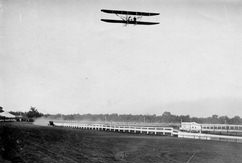
The Model B was also used extensively for exhibition flights. Here,
a Model B races and automobile.
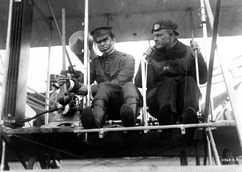
Lt. Myron Crissy demonstrates how he dropped the first live bombs
from a Model B. Phil Parmalee is the pilot.
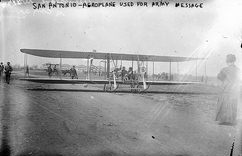
The first military radio-equipped airplane was a Wright Model B.
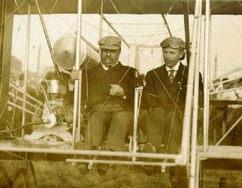
The former President Theodore Roosevelt flew with Arch Hoxsey in a
Model B at St. Louis in 1911.
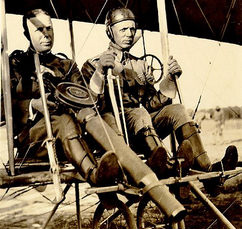
In 1912, inventor Isaac Lewis asked Capt. Charles Chandler, the head
of the Army Aeronautical Division at College Park, to test-fire a
prototype machine gun from a Model B in flight. Despite the success of the test,
the Army declined to purchase the invention. Frustrated, Lewis took his gun to
Britain in 1913 where the military immediately recognized its potential. The Lewis Gun
became standard armament on British aircraft
in World War I.
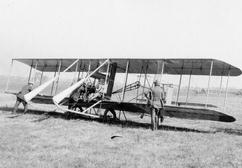
The 1916 Model B on display at the United States Museum of the Air
Force was last flown by Lt. John A. Macready at the 1924
International Air Races in Dayton, Ohio. It has an eight-cylinder,
75 hp Rausenberger engine instead of the
standard Wright engine and uses ailerons instead of wing warping.
Whether or not these were modifications or it was built this way at
the reconstituted Wright Company is unclear.
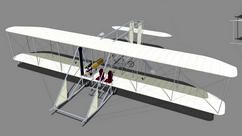
Detailed illustrations of the Wright Model B from several angles.
|
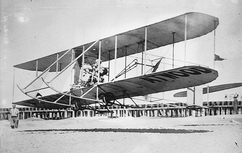
A later Model B, probably produced after 1911. As the aircraft
design evolved, the Wrights shortened the skids and removed one
diagonal brace from each side.
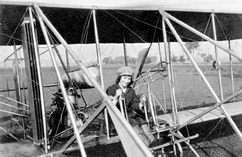
The cockpit of the Model B. The pilot is Marjorie Stinson, an early
American aviatrix who learned to fly at the Wright Flying School.
The Wrights used the Model B extensively for flight training.
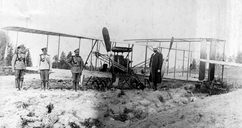
The Model B was produced by Wright-licensed companies in other
countries. This aircraft was made in Germany.
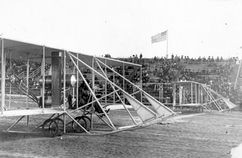
Sometimes the members of an exhibition flying team would race each
other. Here, two Model Bs line up for a race.
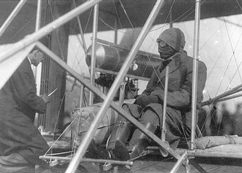
Wrapped head to toe in leather and wool to protect himself from the
cold air in the open Model B cockpit, Phil Parmalee prepares to fly
the first air freight -- two bolts of silk. Orville Wright oils the
engine.
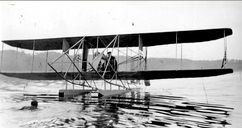
The US Navy''s first airplane was a Model B on pontoons. Here, one
of the flight crew swims out to the Model B to tow it to dock.
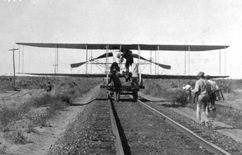
Robert Fowler crossed America in a Model B, surviving a long string
of hardships. When he landed among the sage and cactus in New
Mexico, there was no clear, level field to take off from. So he
launched from a flat
car that rolled along the railroad tracks.
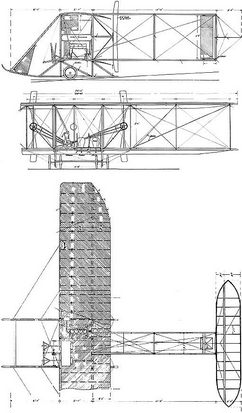
Wright Model B side view, front view, and top view.
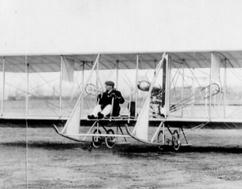
The only Model B that is certain to have survived intact was purchased by Grover Cleveland Bergdoll in 1912 and donated to the Franklin Institute in 1933. It
was flown briefly after it's restoration in 1934, making it the last
original Wright airplane to fly.
|